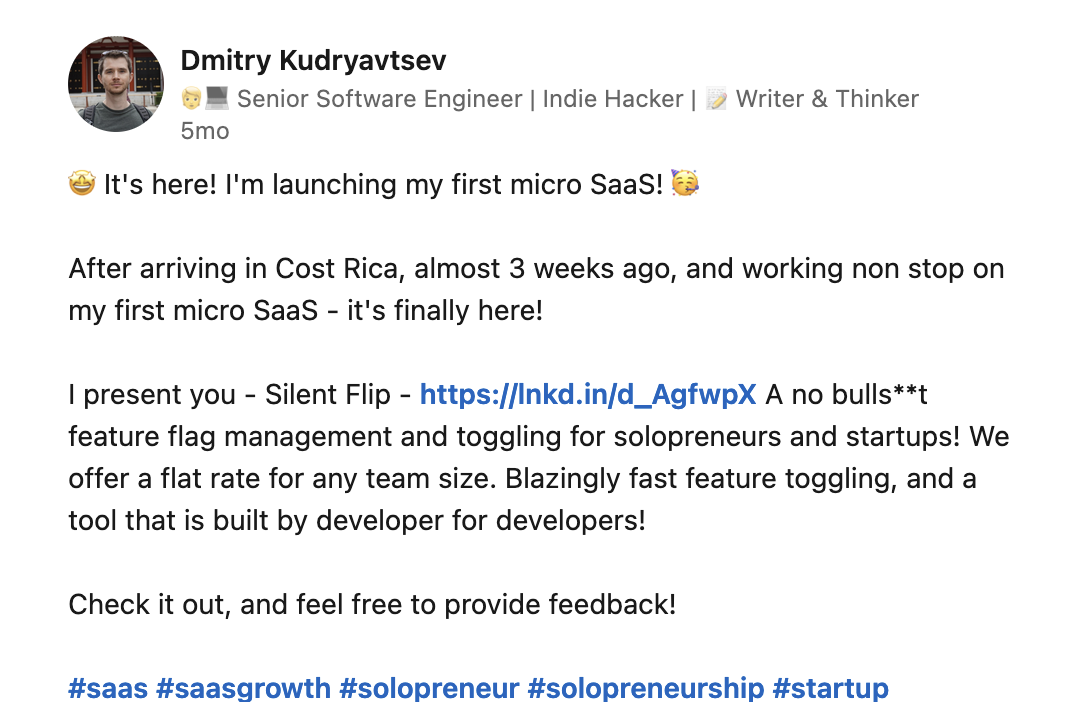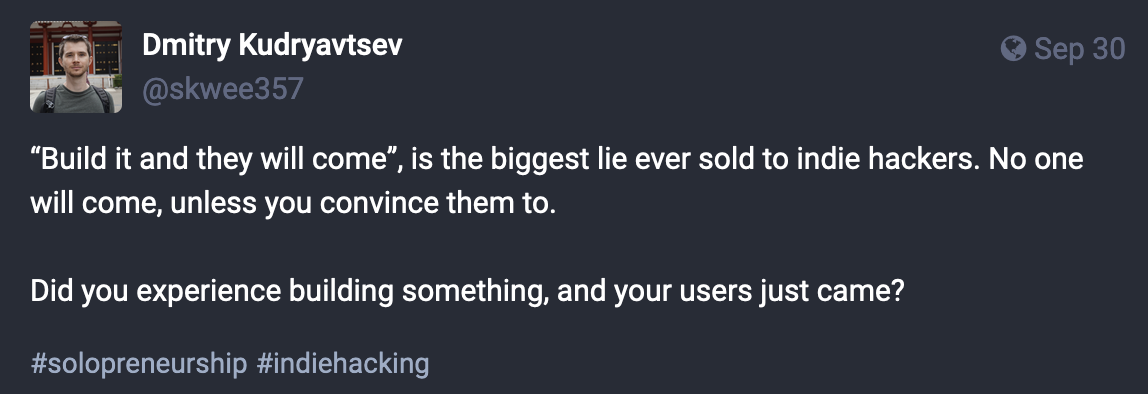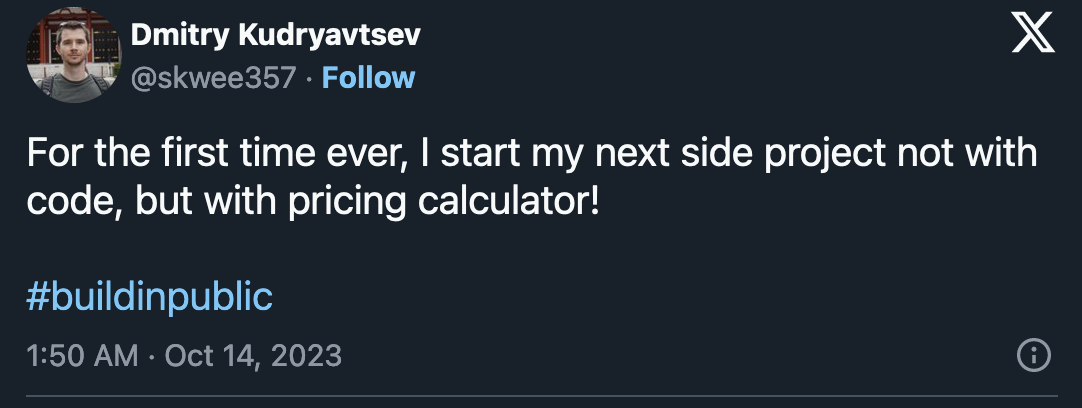6 lessons from building 6 projects, while nomading for 6 months
Six months ago, I boarded a one way flight to Costa Rica. A month prior to that, I quit my job after being burnt out. My apartment lease ended, I sold almost everything I own, and packed the rest into a backpack and a suitcase.
I had a simple plan: slow travel, work on my mental and physical health, and build a sustainable online business. I didn’t have a job, and was relying solely on my savings. This gave me all the time I need to focus on the above goals.
With time, from Costa Rica I moved to Guatemala, and then to Mexico. And after exactly 6 months, at the beginning of December, I boarded my last flight in 2023 for a permanent move to The Netherlands, a country to where my wife and I—relocated. I want to give you a short overview of my projects, and what I learned from them.
Disclaimer: I actually launched 8 different products. However, 4 of them can be put in 2 categories, so in total I launched 6 different product categories, each with different mindset. Felt like I need to clarify this, in order to avoid comment on the somewhat, misleading title.
Lesson #1: Build it, and they will come—is a lie
After landing in Costa Rica, and taking the first few days to adjust to the time difference, eventually I got to work on my first project: SilentFlip. I had the idea for SilentFlip in my head long before I decided to quit my job and nomad. The rationale was simple: take an existing product and build a copy that targets a different market. In my case, I wanted to build a remote feature toggling service that will target solopreneurs and small startups. Existing solutions are targeting big enterprises that can afford to pay per seat, which many solo builders can’t.
After spending some time building the MVP, and doing the landing page, I finally bought the domain, and shared the launch post on LinkedIn (where I’ve been somewhat active for the past 1.5 years). I got a modest amount of views to the post, and some small amount of likes. The landing page had no option to purchase the product, and instead I was collecting emails based on the desired price tier (I had 3 tiers).

I got this tip from Tim Ferriss’s book—The 4-hour work week—where he recommended setting up a landing page where you would collect customer intentions to buy the product. The idea behind this is that you don’t want to spend time developing a product if you can’t really sell/market it. However, looking back at it, I believe this is a wrong approach. I’ll cover this in a different lesson below.
But back to the original lesson. I, like many technical founders, believed at that time in the “build it, and they will come” mantra. I learned the hard way that this is not how it works. Unless you build a unicorn, there is a big chance that every market you will try—is saturated with competition. And when people search for a remote feature toggling service, there is a high chance they won’t land on my landing page.
In the end, nobody cares how perfect your product from a technical viewpoint, and this is what many technical solopreneurs/indie-hackers don’t get. You can build a product in a saturated market, and get customers, as long as you don’t just throw it in the void an expect people to magically find it because “it’s written using amazing technology!”

Lesson #2: Don’t build communities
Like a good indie-hacker, after seeing no traction from my first product, I ditched it and launched not one, but two, different products: Artisan Brew Coffee and PetAway.
Artisan Brew Coffee is a community for coffee lovers. Not the Nespresso type, but rather the pour over type. I got this idea after visiting a coffee plantation in Costa Rica, and as a coffee lover, decided to launch this community.
PetAway is a “scratch your own itch” type of product. Since I didn’t plan to come back to my home country, but rather wanted to end up in The Netherlands—my wife and I had to take our dog with us. And if you ever travelled with pets—you know what hell you need to go through. So I launched this community together with my wife in order to share knowledge for travelling with pets.
And here comes the second lesson: don’t build communities.
When you build a product that does not need a community, your success depends on two things: the quality of the product, and how widespread it is (read: marketing). It doesn’t matter how many people bought this product yesterday. As long as you are able to attract new customers, you will make profit.
With the community, on the other hand, you depend a lot on the members of the community. Nobody wants to be a member of a community which doesn’t have any members. So you are stuck in a catch-22 scenario: you need members for your community, but in order to gain more members, you already need to have members. There are ways to overcome this such as creating lots of content, or even fake profiles, in order to attract initial members. But it’s just another thing you need to take care of, in addition to moderating the community. And as a solopreneur—you already have a lot of things you need to take care of.
Lesson #3: Make sure to have a business plan
My two next products were LibrePress.io—an “own your content” type of newsletter distribution platform, I even wrote a blog post about it; and Remote or Not—A list of all companies by their remote and work-from-home policy. Both of them “failed” because I didn’t have a solid business plan.
LibrePress was born out of idealistic motivation: I’m a big believer in owning your content, and I wanted a newsletter platform that focuses on distribution without caring how you create the content. The idea was to distribute RSS feeds, or upload markdown files. I wanted to switch my newsletter to it, soon after launch. However, what I failed to take into account, is the running cost. Given the amount of newsletter readers I have, and the pricing for the hosting+email provider—I would end up in a range of $15-$20 per month, just to distribute my newsletter. This is too expensive for me at the moment, given the fact that currently I pay nothing (in monetary terms), and other services exist that charge less. Obviously, if I had paying customers, that would make it more cost-effective to switch, but I didn’t even come up with a pricing plan for LibrePress.
Remote or Not, on the other hand, was born out of my endless side-project ideas list. At the time of building it I was searching for a job with a strong preference for hybrid or fully remote policy, and couldn’t find a reliable source of such information. While I still maintain Remote or Not, it failed on two fronts: it’s a somewhat community based product (I depend heavily on contributions); and it didn’t have any clear business plan. It doesn’t have enough traffic to put ads. I didn’t want to charge job-seekers in order to get access to the information. As for companies, I’ve added a form for a company representative to reach out to me and provide official remote work policy for their company, with the intention to charge companies in the future. So far, no company reached out.
And, speaking about pricing plans…
Lesson #4: If you don’t charge, you don’t make money
Sounds obvious, right? But so many indie-hackers, including myself, ignore this lesson. There is this mental barrier to charge money for something. The moment you reach this milestone, you start to question yourself: am I good enough; is the product worth it; what if nobody buys it; etc. But the truth is, and circling back the advice from Tim Ferriss’s book, if you don’t charge—you don’t make money.
Collecting emails is not the same as collecting money. People are way more willing to sign up to alpha, beta, closed releases, and any other free services. But the moment they need to pay for something, it’s a completely different mindset. Tim’s advice was focusing more on physical products, where you have a high cost of manufacturing. In that case yes, I think it’s better to set up a fake shop, but guide the user through purchase flow, to clearly identify people who are willing to pay now, rather than collect emails of people who might pay in the future. But when you build a digital product, the cost of which is nearly zero, you need to charge money from the get-go. Otherwise, you are building a pet project, and not a business.
And it took me almost 4 months to realize it, and eventually launch JustFax Online—a super simple, e-fax solution. It was the first product I finished from A to Z. It had a working MVP, and I was charging money from the start. So far, JustFax and the two other products I’ll talk about in the next lesson, are the only products that make me money.
And coming back to the previous lesson, JustFax online was the first product where I actually had a business plan. I created an Excel spreadsheet and calculated different cost scenarios of operating such service: how much would I pay for sending the faxes, how much is the infrastructure, how much should I charge, etc.

Lesson #5: Think about distribution
Looking back at SilentFlip, Artisan Brew Coffee, PetAway, LibrePress, and Remote or Not, the reason they failed—is lack of distribution channels. Distribution channels can be advertisement, but it also can be a personal brand. And this is what happened to me when I launched my two books: Technical Writing for Software Engineers - A Handbook and From Applicant to Employee - Your Blueprint for Landing a Job in Tech.
Both of my books are available on Gumroad, which is a marketplace for digital goods. And while marketplaces and app-stores are a great way to distribute your products, they are, like anything else, saturated with content. There is a way to succeed on marketplaces/app-stores, but this is a topic for another blog post. Most of the sales of my books came from this blog, my newsletter, and my social network presence (Twitter, Mastodon, and LinkedIn).
I started to write my first book after the “failure” of Artisan Brew Coffee and PetAway, and at that time I started to be active on Twitter, Mastodon, and LinkedIn (where I’ve been active, but mainly promoting my blog). Being active on social media is a good distribution channel. If you are consistent, share quality content, and try to engage with the community—you essentially get “free” customers. The #buildinpublic hashtag is filled with solopreneurs and indie-hackers that are building products and sharing their experience.
But the problem is—you need to know your audience. If you are branding yourself as a software engineer, like I do, it becomes easier to distribute products targeting software engineers. And I saw it with both of my books. As I’ve said, most of my sales came through Twitter/Mastodon and my blog. However, if we look at JustFax—the target audience is not software engineers or indie-hackers. And while I got great feedback from both Twitter and Mastodon about JustFax, most of the sales didn’t come from these platforms.
And this is why it’s important to think about your distribution channels. Moreover, what worked for one product, will not necessarily work for another. This is why with JustFax, I’m focusing more on SEO and organic growth, and considering experimenting with advertisement.
Lesson #6: You only fail when you quit, or in other words: consistency wins
Few days ago I had a chat with my friend. He is also an indie-hacker who is trying to build a side-business. We talk once in a while and share ideas, and revelations. During our call, we were talking about consistency, and I came up with a great analogy.
Imagine you play a game. I grew up playing Dungeon Siege, so I’ll describe the setup from it. You are spawned as a peasant in burned down village. The entire kingdom is infested with evil creatures such as orcs, and the only hope to save the kingdom from evil force—is you. In this village, behind a burning house, you find a pitchfork. You take it and go kill your first two orcs. And get your first level-up to level two where you can assign skill points.
But then you quit the game, and the next time you relaunch it, you don’t start where you’ve quit—you start from the beginning, with the pitchfork behind a burned house, on first level, with both orcs alive, and zero skill points to assign.
This is how it works if you are not consistent. Every time you quit, or start a new project—you start from zero. Yes, you prefect some craft. I, for example, can build landing pages in less than a day now, because I built 6 of them. But only with JustFax I was able to get to a new level, unlock new abilities and knowledge. None of my other products reached a point where I had to take care of customers, collect payments, deal with bug fixes, focus on ads and SEO, etc.
If I had to start over again today, I would focus on one product for as long as possible, taking into account all the above lessons about community, distribution, and charging from the start. The moment you switch to a new product, and indie-hacker (myself included) like to switch often, you don’t start from the same point you left your last project—you start from zero. Yes you have prior experience, and starting over will be faster. But if none of your products reached a phase where you need to focus on SEO, you can start 100500 new products—but you won’t learn about SEO.
This is why it’s important to stay consistent. It’s perfectly fine to quit, and start a new product. But it’s only when you go through the whole journey, starting from idea, to product, to launch, to marketing and distribution, to taking payments, to fixing bugs and doing customer support; only then you are allowed to quit and start a new product. Otherwise, you risk running the same 100 meters of a marathon over and over again. Which is fine, if you want to be the fastest runner of 100 meters. But if you want to finish the marathon, you need to stay consistent.
Bonus lesson #7: Share it with the world
I remember how scared I was before launching SilentFlip on LinkedIn. You get all these thoughts: you are not good enough; nobody needs it; you will just embarrass yourself. And I had the same feeling with every other product I launched afterward. It goes away little-by-little, but if you don’t share your work out there, you won’t succeed. No matter how stupid you feel, just share it.
Final Words
These were amazing 6 months. I’ve acquired an enormous amount of knowledge, and most importantly practical knowledge, which worth more than every theoretical knowledge you get. In addition to that, this has been a great time to cure my burnout and restart my career. I’m still analyzing everything from this trip, and planning to compile it to a few more blog posts, so stay tuned.
I would like to use the final words as an opportunity for self-promotion.
- If you ever need to send a fax online, consider giving JustFax online a try. I’m open to feedback, so feel free to reach out to me.
- If you are a software engineer who want to take your career to the next level, you need to be able to write technical documents. In that case, consider getting my handbook: Technical Writing for Software Engineers. It contains all my knowledge regarding technical writing.
- If you found yourself laid off from your job; you want to switch to a new job; or you want to get into tech—consider getting my and my wife’s book: From Applicant to Employee: Your Blueprint for Landing a Job in Tech. It contains my and my wife’s (Senior Talent Acquisition, Technical/Executive Recruiter, and Career Coach) entire knowledge about technical interviews, how to pass them, and how to prepare. We used tips from this book in our recent search for a new job.
- If you are interested in starting a side business, but don’t have ideas or ability to build your own product—I offer SilentFlip and Artisan Brew Coffee for sale. You can buy any part you want: domain, website, potential leads. I’m open to sell LibrePress.io and Remote or Not as well, as I don’t have much time to work on them. Reach out to me (email, or social networks), and let’s discuss it.
And as always, consider subscribing to my newsletter to never miss an update from this blog. Follow me on Twitter, Mastodon, and LinkedIn—where I share a lot about software engineering, as well as solopreneurship, indie-hacking, and building in public my projects.